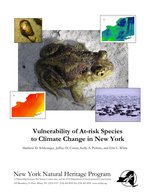Vulnerability of At-Risk Species to Climate Change in New York
Project Sponsor: New York State Department of Environmental Conservation - Division of Fish and Wildlife
End Date: March 1, 2011
Summary
In this project, we calculated the relative vulnerability to climate change of 119 of New York’s Species of Greatest Conservation Need (SGCN) using NatureServe’s Climate Change Vulnerability Index (CCVI). We combined literature review and modeling data with expert opinion to derive these assessments
that complement our conservation status ranks (S-ranks).

Citation:
Schlesinger, M.D., J.D. Corser, K.A. Perkins, and E.L. White. 2011. Vulnerability of at-risk species to climate change in New York. New York Natural Heritage Program, Albany, NY.
The full report: Vulnerability of At-risk Species to Climate Change in New York (PDF, 2.1 MB).
Abstract:
Vulnerability assessments are rapidly becoming an essential tool in climate change adaptation planning. As states revise their Wildlife Action Plans, the need to integrate climate change considerations drives the adoption of vulnerability assessments as critical components. To help meet this need for New York, we calculated the relative vulnerability of 119 of New York’s Species of Greatest Conservation Need (SGCN) using NatureServe’s Climate Change Vulnerability Index (CCVI).
We selected species spanning taxonomic groups that we thought 1) might be susceptible to climate change, 2) would be good indicators of vulnerability of species in similar habitats, and 3) would have sufficient data to allow conducting the assessment. The CCVI treats climate-change vulnerability as resulting from two factors: exposure and sensitivity. Direct exposure to climate change is assessed using predictions of future changes in temperature and moisture availability based on averages of global circulation models. Indirect exposure considers predicted sea-level rise, existence of barriers to movement, and effects of alternative energy development. Sensitivity is assessed using a variety of factors, including dispersal capability, known sensitivity to changes in temperature and moisture regime, reliance on interspecific interactions, genetic diversity, and expected phenological shifts with changing climate. Finally, the CCVI incorporates documented and modeled effects on the target species. The output is one of five categories of vulnerability: Extremely Vulnerable, Highly Vulnerable, Moderately Vulnerable, Not Vulnerable/Presumed table, or Not Vulnerable/Increase Likely. The CCVI also provides a confidence estimate for the information provided.
In New York, species ranged from Highly to Extremely Vulnerable (e.g., frosted elfin, brook floater, tiger salamander) to Presumed Stable (e.g., timber rattlesnake, russet-tipped clubtail, spotted turtle). Nearly all species rated as Highly or Extremely Vulnerable were associated with aquatic or seasonally wet habitats. Mussels emerged as especially vulnerable to climate change, given their low mobility, issues with aquatic connectivity, and reliance on other species for dispersal. The primary factors that drove our assessments included genetic variation, phenological responses, natural and anthropogenic barriers to dispersal, and restriction to specific geological features. Vulnerability was only weakly associated with conservation status. Species at the southern edge of their range in New York might become extirpated from the state. Our results agreed broadly with those from Pennsylvania and West Virginia.
Jan. 12, 2021 | Updated Feb. 8, 2021, 10:57 p.m.